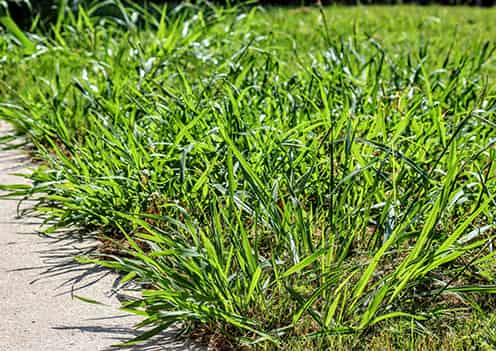
Native to Europe and Eurasia, the weed crabgrass offers its seeds worldwide. The name is Latin for “fingers.” It looks like ordinary grass except it's light green and growing multiple blades on one stalk.
Crabgrass is an annual plant. This means that the weed dies off after the first frost of fall, leaving behind bare brown dirt. The weed is reborn in the spring, filling in those bare spots and spreading to other spots.
One crabgrass plant produces from 150 up to 700 fingers. It's capable of producing 150,000 seeds. Reading that, you'd think it's hard to destroy crabgrass, but it can be done. Here's how.
How to Remove Crabgrass
If you're the type of homeowner who doesn't like store-bought solutions, then you can make your own weed killer out of vinegar. Mix one gallon of white vinegar with one cup of Epsom salts and one tablespoon of dishwashing soap. Pour mixture into a spray bottle. Now spray those weeds into submission.
Another way to rid yourself of crabgrass is to dig it up by its roots. Its root system is shallow. However, you should place the plants in a trash bag for disposal. If you don't, the seeds will germinate all over again.
Fun Fact: Crabgrass concoctions are used for treating cataracts.
Rid Your Lawn of Crabgrass With A Healthy Lawn
Crabgrass needs lots of sun to grow. A healthy stalk of grass will have a deep root system, and it will stand tall. Even keeping the grass at three inches in height will kill crabgrass due to the shade it throws. The healthy root system of the grass will choke out the root system of the weeds.
Water your grass thoroughly twice per week. Soaking the root system allows the grass to grow to become hardy. It will also resist heat better. A daily sprinkling of water on the grass means a shallow root system and weaker grass.
Keep the ground free from compaction. Compacted soil can't let the sun, water, and nutrients get to the root system. Use an aerator once a year, if your lawn is subject to walking, biking, playing, and other methods of compaction.
Be aware of the nitrogen needs of your lawn. Fertilizers that say “green up” have excess nitrogen. This will weaken your lawn over time. Choose a product that uses slow release for its nitrogen content. Use about three pounds of nitrogen for a 1,000 square foot lawn each year.
Fun Fact: Crabgrass seeds are ground to be used as flour. This flour is used to make semolina.
If Natural Methods Don't Work
If vinegar doesn't work, homeowners might have to go with a more advanced approach. Store-bought weedkillers are very good at taking out weeds. Begin with a pre-emergent solution after cutting the grass for the first time in spring. This will form a barrier at the soil. The seeds absorb the chemical and die.
Wait about six weeks to treat the lawn again. If the crabgrass problem is too much to handle, then use the next weed killer in line, also known as post-emergent weed killer. It's not necessary to spray the whole lawn again. Spray just the patches of weed that are stubborn and won't die. If you don’t have the capacity to deal with it yourself (and who could blame you with how busy everyone is nowadays), then it might be time to hire lawn care services.
Regardless, be sure to water the soil thoroughly two days after you've sprayed the weeds. This allows the herbicide to be better absorbed. If you got a bit enthusiastic with the weed killer, just water the brown grass to dilute the chemical. It will snap right back to green life.
The seeds of weeds are carried by birds, bees, butterflies, and other pollinators. All homeowners can do is control or kill the weeds before they take over the whole lawn. As long as you educate yourself, you can be prepared for many (if not most) lawn troubles that will come your way.
Reggie Moore is a professional writer and proto-entrepreneur. When not trying to tinker with a new thing, process, or idea, Reggie can usually be found saying the words “Well, actually…” to an unsuspecting bystander.
Post new comment
Please Register or Login to post new comment.